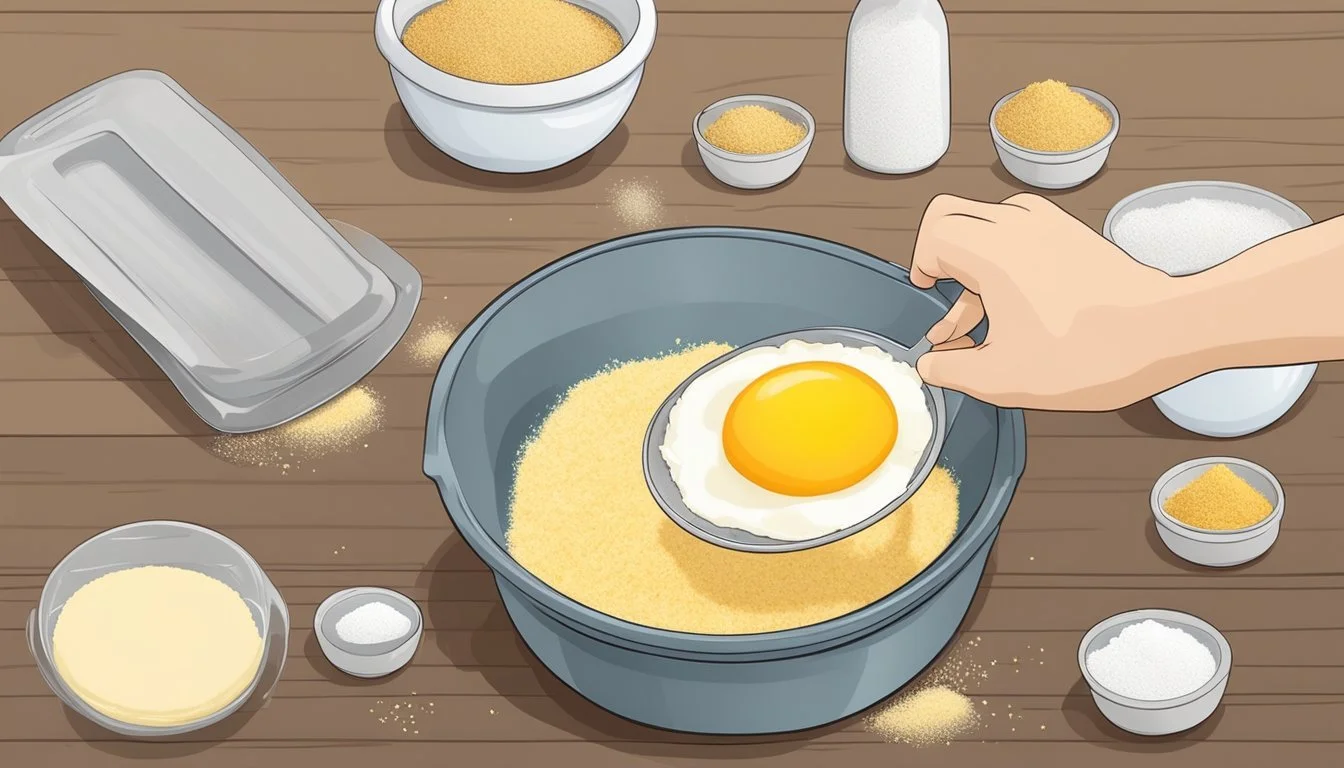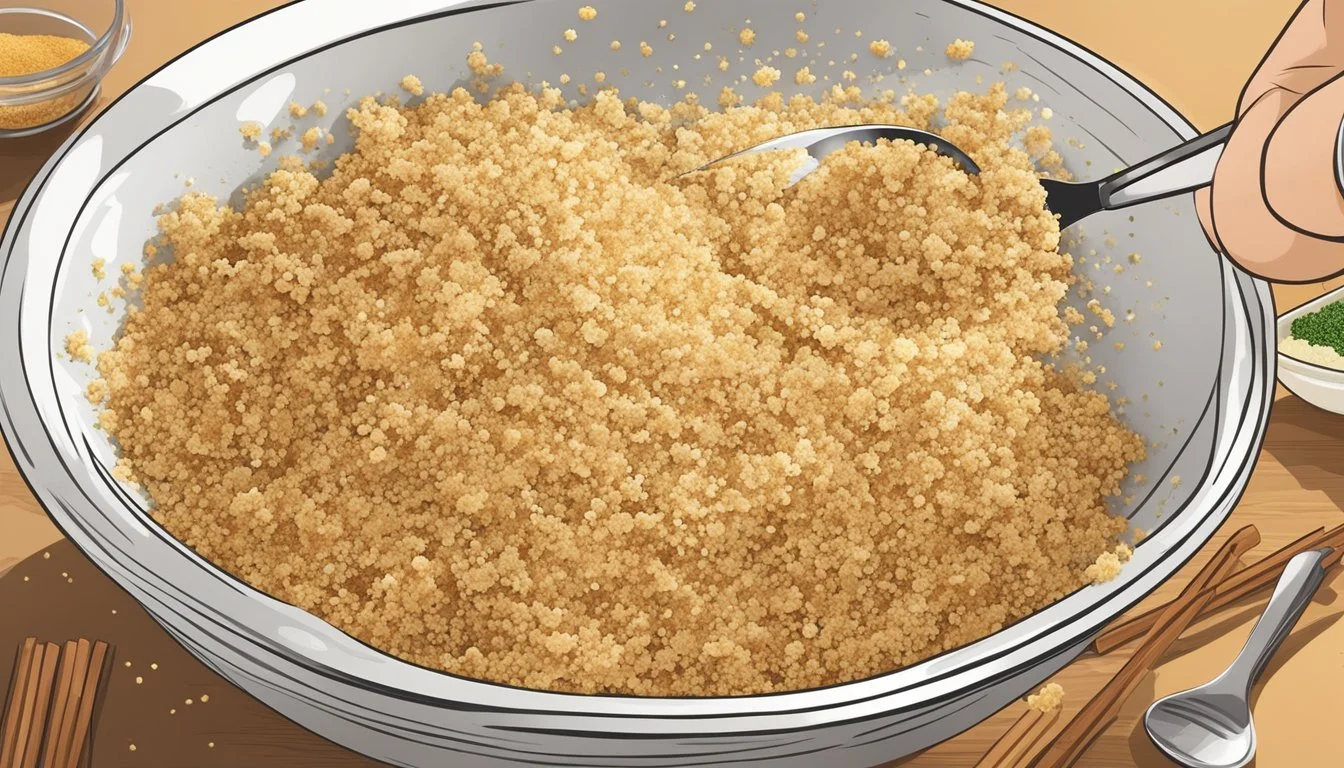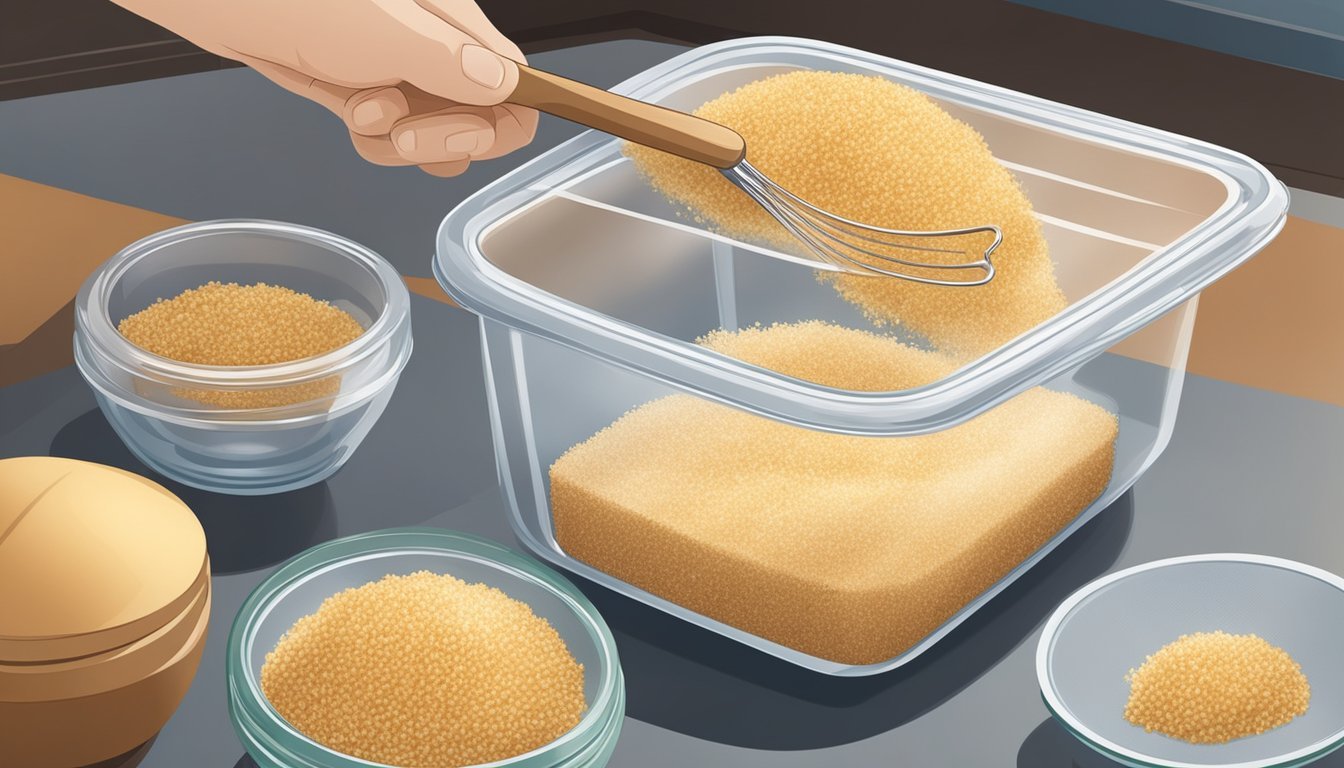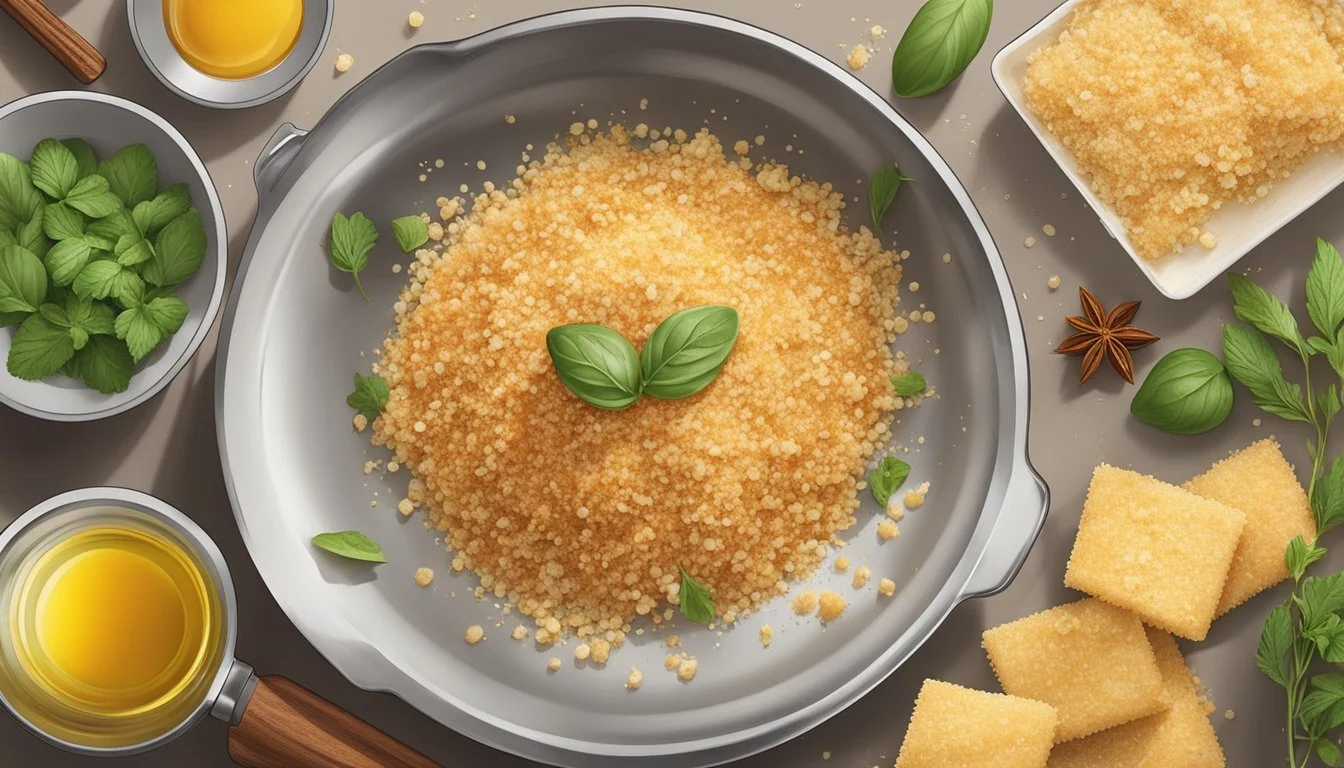Reviving Stale Panko Breadcrumbs
Effective Tips for Ensuring a Crisp Fried Finish
Stale panko breadcrumbs need not be discarded as they can often be brought back to life with the right techniques. Recognized for their light, airy texture and consistency, panko breadcrumbs are a preferred choice for achieving an exceptional crispy coating on various fried foods (What wine goes well with fried foods?). From the outer layer of succulent fried shrimp to the finest crisp layer atop baked dishes, panko breadcrumbs add not just texture but also an extra dimension of flavor. However, like many pantry staples, they can lose their freshness and optimal texture over time, necessitating revival to reclaim their crunch.
Revitalization involves gently toasting the dried out panko to eliminate any residual moisture that softens their crunch. This process not only restores their crispy quality but it also enhances their golden color, making them nearly as good as new. By spreading them evenly on a baking sheet and heating them in a low-temperature oven, they can be rejuvenated effectively. Care must be taken to stir them occasionally to ensure even drying and to prevent them from toasting too much, as the goal is to dry them out, not to cook them further.
When stored correctly in a cool, dry place away from direct sunlight and moisture, panko breadcrumbs maintain their quality for extended periods. The shelf life of panko can extend up to six months under ideal conditions. It is essential, however, to inspect them regularly for spoilage signs such as off odors, discoloration, or clumping. Should any of these signs appear, it's advisable to discard the breadcrumbs to avoid potential food spoilage. Through proper storage and revival methods, panko breadcrumbs continue to be an indispensable ingredient in the kitchen, ready to bring a satisfying crunch to a plethora of dishes.
Understanding Panko Breadcrumbs
Panko breadcrumbs play a pivotal role in creating crunchy coatings for fried foods. They offer a unique texture and lightness that sets them apart from regular breadcrumbs.
Origins of Panko
Panko breadcrumbs originated in Japan and are made from a special kind of crustless bread. This bread is processed into large, airy flakes after being steamed and dried, which is in stark contrast to the crumb-making process used in the West. Panko translates to "bread powder" but their flaky nature is far from powdery.
Panko vs. Regular Breadcrumbs
The primary differences between panko and regular breadcrumbs are in their texture and absorbency. Panko breadcrumbs are lighter, flakier, and crisper compared to their Western counterpart. This uniqueness is due to the type of bread used—typically white and crustless—and the particular method of production. Panko flakes are larger, resulting in a coating that absorbs less oil and stays crispier for longer when used in frying.
Nutritional Comparison
When considering the nutritional aspects, panko may differ from regular breadcrumbs in terms of calorie and fat content. Often, panko can contain fewer calories and less fat per serving compared to regular breadcrumbs. However, the nutritional content can vary by brand, so it’s important to read labels carefully. Here is a brief nutritional comparison based on typical values:
Nutrient Panko Breadcrumbs (per 100g) Regular Breadcrumbs (per 100g) Calories 350 395 Total Fat 1.3g 5.3g Saturated Fat 0.3g 1.3g Carbohydrates 72g 71g Dietary Fiber 5g 4g Protein 13g 14g
The texture and nutrition of panko breadcrumbs make them a popular choice for creating a lighter, crispier coating on fried dishes.
Reviving Stale Panko
Occasionally, panko breadcrumbs lose their crisp texture and become stale, but they can be revitalized to regain their desirable crispy quality. This section provides steps one can follow to identify staleness and methods for refreshing panko breadcrumbs.
Signs of Staleness
One can identify stale panko breadcrumbs by a lack of crunchiness and a denser texture. Moisture is often the culprit, as it causes the crumbs to clump together and lose their distinct flakiness. Stale breadcrumbs may also have a dull appearance rather than a golden fresh look, and they may emit a musty odor.
Methods for Freshening
To freshen stale panko breadcrumbs, one can utilize the following method:
Oven Toasting: Preheat the oven to 250°F (approximately 120°C). Spread the panko breadcrumbs in a thin layer on a baking sheet and lightly toast them in the oven. Stir every few minutes to ensure even drying, and continue the process for 15 to 20 minutes until they regain a dry and crispy texture. Be cautious not to over-brown the breadcrumbs, as this can affect their flavor.
For those who prefer a stovetop method:
Stovetop Toasting: Place the breadcrumbs in a dry skillet over medium heat. Stir constantly for a few minutes until they are dry and crispy once again. Adding a small amount of oil can help them regain their crispiness, but be mindful to use just enough to lightly coat the crumbs to avoid making them greasy.
After the breadcrumbs are refreshed, they should be stored in an airtight container to protect them from moisture and preserve their crispy texture.
Application and Usage
In this section, we focus on practical ways to use panko breadcrumbs which can enhance the texture and taste of various dishes. They serve as a crispy coating, provide a crunchy topping, or act as a binding agent while maintaining a crispy exterior in fried foods.
Crispy Coatings for Meat
For creating a perfectly crispy coating on meats such as chicken tenders or fish fillets, panko breadcrumbs are the go-to choice. Their larger, airier flakes offer a lighter texture than traditional breadcrumbs.
Chicken: Coat chicken pieces in flour, dip in beaten eggs, and then dredge in panko crumbs seasoned with salt and pepper before frying in hot oil.
Fish: Similar to chicken, coat the fish pieces before frying or baking for a golden, crispy crust.
Crunchy Toppings for Casseroles
Panko breadcrumbs can be used as a crunchy topping for casseroles (What wine goes well with casseroles?) and gratins, adding a pleasant contrast to the creamy interior.
Casseroles: Mix panko with melted butter, grated cheese, and herbs, and sprinkle over your casserole before baking.
Gratins: For gratins, a generous layer of seasoned panko on top adds texture and flavor.
Binding Agent for Meatballs
Panko breadcrumbs are also effective as a binding agent for meatballs, helping to retain moisture and shape while adding a slight crunch.
Meatballs: Combine ground meat with panko, eggs, seasoning, and finely chopped onions for meatballs with a firm yet tender texture.
Innovative Recipes and Variations
Exploring the versatility of panko breadcrumbs, this section is dedicated to infusing creativity into your cooking. It lays out how one can craft homemade panko variations and offers options for gluten-free and substitute solutions.
Homemade Panko Variations
Recipe creators have the latitude to customize homemade panko breadcrumbs for unique flavor profiles. One can toast store-bought or homemade panko in a skillet with a blend of herbs and spices to season their coating. Here's how you can enhance your panko:
Classic Herb Mix: Combine panko with dried parsley, oregano, and thyme for a traditional twist.
Spicy Kick: Add paprika and chili flakes to the panko for dishes that demand heat.
Cheese Extravaganza: Grate Parmesan into the breadcrumbs for a cheesy, umami-packed crust.
Each variation lifts a simple coating to new heights, amplifying the essence of the dish.
Gluten-Free and Substitute Options
For those seeking gluten-free options or wish to substitute traditional panko, several ingredients come to the rescue without compromising the coveted crunchiness:
Gluten-Free Panko: Available in stores, it mimics the texture without gluten.
Cornflakes: Crushed cornflakes are an excellent gluten-free and crunchy alternative.
Almond Flour: A nutritious, low-carb substitute that's perfect for binding and breading.
It's vital to note that substitutions may alter cooking times and temperatures, so one should monitor the cooking process closely to achieve the desired golden-brown finish.
Preserving and Storing Panko
Properly storing panko breadcrumbs is essential to maintain their quality and extend their shelf life. Following best practices for storage can aid in preserving their crispy texture.
Best Practices for Storage
Temperature and Environment: Panko breadcrumbs should be kept in a cool, dry place such as a pantry. Exposure to heat and humidity can cause them to spoil faster.
Packaging: It is crucial to store panko breadcrumbs in an airtight container. Once the original packaging is opened, transferring the panko to a container with a tight seal can protect it against moisture and pests.
Storage Location Expected Shelf Life Pantry Up to 6 months after opening Refrigerator / Freezer Even longer, maintaining quality
Reusing Leftover Panko
Refreshing Technique: If panko breadcrumbs lose their crispy texture, they can often be rejuvenated. Spread them on a baking sheet and lightly toast them in an oven at 250°F for about 10 to 15 minutes or until they are dry and crisp once more, then allow them to cool before returning them to storage.
Freezing: Leftover breadcrumbs can be frozen. By placing them in an airtight container or a sealable freezer bag, one can extend their usability significantly, allowing them to be used in future recipes without compromising on quality.
Advanced Cooking Techniques
Mastering advanced cooking techniques elevates the use of panko breadcrumbs in creating a crispy coating for fried foods. Through meticulous deep frying and breading methods, chefs can achieve a perfect golden crust on proteins and vegetables.
Deep Frying with Panko
For an exceptional crispy crust, the temperature of the oil is crucial. It should be heated between 350°F to 375°F—the ideal range to ensure that panko-breaded foods cook quickly and develop a golden brown exterior without absorbing excess oil. Chefs often use a thermometer to monitor the oil's temperature. Moreover, to maintain the oil's temperature, fried items should be cooked in batches, avoiding overcrowding that can lower the oil's heat and lead to soggy results.
Key Steps for Deep Frying with Panko:
Heat oil in a deep fryer or a deep pot to the correct temperature.
Gently lay the breaded items into the hot oil without overcrowding.
Fry until the coating is evenly golden and the food is cooked through.
Remove fried items with a slotted spoon and drain on a wire rack or paper towels.
Breading Proteins and Vegetables
The breading technique plays a pivotal role in ensuring that proteins and vegetables are evenly coated with panko breadcrumbs for a consistent crispy coating. A standard breading process involves three steps: dredging in flour, dipping in egg wash, and then coating with panko breadcrumbs. For added texture, some chefs may season the panko with herbs or spices before coating.
Key Steps for Breading:
Dredge the item lightly with flour, shaking off any excess.
Dip into beaten eggs, allowing any excess to drip off.
Coat evenly with panko, pressing gently to adhere the crumbs.
Tip: For an extra crispy layer, some chefs double-bread by repeating the egg wash and panko steps. This creates a thicker crust and is ideal for larger pieces that require longer cooking times.
Health and Dietary Considerations
When it comes to health and dietary considerations, choosing the right breadcrumbs and preparation techniques can make a difference in one's daily nutrition. Panko breadcrumbs can be both a beneficial ingredient and a practical solution for those watching their caloric intake while seeking a crispy texture in their meals.
Reducing Caloric Intake
One may reduce their caloric intake by opting for panko breadcrumbs as they often absorb less oil than traditional breadcrumbs during frying. This can result in a lower fat content per serving. To further decrease the caloric content:
Bake instead of fry: Using panko for oven-baked recipes can lower fat content, as less oil is needed.
Portion control: Monitor the amount of breadcrumbs used. A light, even coating is sufficient to achieve crispiness.
Incorporating Panko in Balanced Meals
Integrating panko breadcrumbs into a balanced meal involves considering the other ingredients in a dish. Panko's nutrition can complement other food groups, such as vegetables and lean proteins. Here are ways to achieve a nutritious balance:
Vegetable incorporation: Encrust vegetables with panko to add texture and increase veggie intake.
Lean proteins: Pairing panko with lean meats like chicken or fish can make for a meal that is both satisfying and within recommended nutritional guidelines.
Incorporating panko breadcrumbs should be done thoughtfully, always considering the overall nutrition of the meal.







